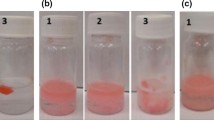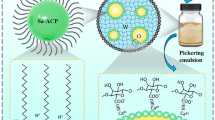Abstract
Porous hydrogels with controlled morphology were successfully prepared from polymerizing soy-protein-isolate (SPI)-stabilized high internal phase emulsions (HIPEs). The ability of SPI to act as a surfactant in an oil-in-water HIPE containing acrylic acid or acrylamide monomer was investigated. The void and window sizes in the polyHIPEs were tailored by adjusting SPI and/or monomer concentration. Ultrasonication treatment was applied to vary the physical properties of the SPI. Although this treatment weakens the emulsifying efficiency of SPI, the HIPEs were stable enough to create polyHIPEs with larger pores and windows than polyHIPEs from untreated counterparts. The formation of polyHIPEs with interconnected, open-cell morphologies indicated that SPI is not a typical Pickering emulsifier. The performance of the hydrogels to capture heavy metal (e.g. lead (II)) ions was also explored. The highly interconnected polyHIPE structure with large voids revealed an enhanced absorption behavior compared with non-porous hydrogels.
Graphic abstract













Similar content being viewed by others
References
Li P, Jin Z, Peng L et al (2018) Stretchable all-gel-state fiber-shaped supercapacitors enabled by macromolecularly interconnected 3D graphene/nanostructured conductive polymer hydrogels. Adv Mater 30:1800124
Yang C, Wang W, Yao C et al (2015) Hydrogel walkers with electro-driven motility for cargo transport. Sci Rep 5:13622
Lee KY, Mooney DJ (2001) Hydrogels for tissue engineering. Chem Rev 101:1869–1880
Cheng C, Liu Z, Li X et al (2014) Graphene oxide interpenetrated polymeric composite hydrogels as highly effective adsorbents for water treatment. RSC Adv 4:42346–42357
Gong JP (2006) Friction and lubrication of hydrogels—its richness and complexity. Soft Matter 2:544–552
Li J, Mooney DJ (2016) Designing hydrogels for controlled drug delivery. Nat Rev Mater 1:16071
Ma J, Yang M, Yu F, Zheng J (2015) Water-enhanced removal of ciprofloxacin from water by porous graphene hydrogel. Sci Rep 5:13578
Zhou G, Luo J, Liu C et al (2018) Efficient heavy metal removal from industrial melting effluent using fixed-bed process based on porous hydrogel adsorbents. Water Res 131:246–254
Barrow M, Zhang H (2013) Aligned porous stimuli-responsive hydrogels via directional freezing and frozen UV initiated polymerization. Soft Matter 9:2723–2729
Xie X, Hu K, Fang D et al (2015) Graphene and hydroxyapatite self-assemble into homogeneous, free standing nanocomposite hydrogels for bone tissue engineering. Nanoscale 7:7992–8002
Liyanage W, Brennessel WW, Nilsson BL (2015) Spontaneous transition of self-assembled hydrogel fibrils into crystalline microtubes enables a rational strategy to stabilize the hydrogel state. Langmuir 31:9933–9942
Silverstein MS (2017) Emulsion-templated polymers: contemporary contemplations. Polymer (Guildf) 126:261–282
Liu G, Liu Z, Li N et al (2014) Hairy polyelectrolyte brushes-grafted thermosensitive microgels as artificial synovial fluid for simultaneous biomimetic lubrication and arthritis treatment. ACS Appl Mater Interfaces 6:20452–20463
Kovačič S, Drašinac N, Pintar A, Žagar E (2018) Highly porous cationic polyelectrolytes via oil-in-water concentrated emulsions: synthesis and adsorption kinetic study. Langmuir 34:10353–10362
Zhang T, Silverstein MS (2019) Robust, highly porous hydrogels templated within emulsions stabilized using a reactive, crosslinking triblock copolymer. Polymer (Guildf) 168:146–154
Jurjevec S, Žagar E, Kovačič S (2020) Functional macroporous amphoteric polyelectrolyte monoliths with tunable structures and properties through emulsion-templated synthesis. J Colloid Interface Sci
Lissant KJ (1966) The geometry of high-internal-phase-ratio emulsions. J Colloid Interface Sci 22:462–468
Silverstein MS (2014) PolyHIPEs: recent advances in emulsion-templated porous polymers. Prog Polym Sci 39:199–234
Ikem VO, Menner A, Horozov TS, Bismarck A (2010) Highly permeable macroporous polymers synthesized from pickering medium and high internal phase emulsion templates. Adv Mater 22:3588–3592
Ikem VO, Menner A, Bismarck A (2010) High-porosity macroporous polymers synthesized from titania-particle-stabilized medium and high internal phase emulsions. Langmuir 26:8836–8841
Zhang S, Xu J, Hu J et al (2017) Interfacial growth of TiO2-rGO composite by pickering emulsion for photocatalytic degradation. Langmuir 33:5015–5024
Zheng Z, Zheng X, Wang H, Du Q (2013) Macroporous graphene oxide–polymer composite prepared through Pickering high internal phase emulsions. ACS Appl Mater Interfaces 5:7974–7982
Chen Y, Wang Y, Shi X et al (2017) Hierarchical and reversible assembly of graphene oxide/polyvinyl alcohol hybrid stabilized Pickering emulsions and their templating for macroporous composite hydrogels. Carbon N Y 111:38–47
Menner A, Verdejo R, Shaffer M, Bismarck A (2007) Particle-stabilized surfactant-free medium internal phase emulsions as templates for porous nanocomposite materials: poly-pickering-foams. Langmuir 23:2398–2403
Kimmins SD, Cameron NR (2011) Functional porous polymers by emulsion templating: recent advances. Adv Funct Mater 21:211–225
Sun G, Li Z, Ngai T (2010) Inversion of particle-stabilized emulsions to form high-internal-phase emulsions. Angew Chemie Int Ed 49:2163–2166
Yan H, Chen X, Song H et al (2017) Synthesis of bacterial cellulose and bacterial cellulose nanocrystals for their applications in the stabilization of olive oil pickering emulsion. Food Hydrocoll 72:127–135
Yan H, Chen X, Feng M et al (2019) Entrapment of bacterial cellulose nanocrystals stabilized Pickering emulsions droplets in alginate beads for hydrophobic drug delivery. Colloids Surf B Biointerfaces 177:112–120
Capron I, Cathala B (2013) Surfactant-free high internal phase emulsions stabilized by cellulose nanocrystals. Biomacromol 14:291–296
Li Z, Xiao M, Wang J, Ngai T (2013) Pure protein scaffolds from pickering high internal phase emulsion template. Macromol Rapid Commun 34:169–174
Liu W, Gao H, McClements DJ et al (2019) Stability, rheology, and β-carotene bioaccessibility of high internal phase emulsion gels. Food Hydrocoll 88:210–217
Ozturk B, McClements DJ (2016) Progress in natural emulsifiers for utilization in food emulsions. Curr Opin Food Sci 7:1–6
Molina E, Papadopoulou A, Ledward DA (2001) Emulsifying properties of high pressure treated soy protein isolate and 7S and 11S globulins. Food Hydrocoll 15:263–269
Nishinari K, Fang Y, Guo S, Phillips GO (2014) Soy proteins: a review on composition, aggregation and emulsification. Food Hydrocoll 39:301–318
Kalashnikova I, Bizot H, Bertoncini P et al (2013) Cellulosic nanorods of various aspect ratios for oil in water Pickering emulsions. Soft Matter 9:952–959
Xu Y-T, Liu T-X, Tang C-H (2019) Novel pickering high internal phase emulsion gels stabilized solely by soy β-conglycinin. Food Hydrocoll 88:21–30
Liu S, Jin M, Chen Y et al (2017) High internal phase emulsions stabilised by supramolecular cellulose nanocrystals and their application as cell-adhesive macroporous hydrogel monoliths. J Mater Chem B 5:2671–2678
Tan H, Tu Z, Jia H et al (2018) Hierarchical porous protein scaffold templated from high internal phase emulsion costabilized by gelatin and gelatin nanoparticles. Langmuir 34:4820–4829
Wang C, Johnson LA (2001) Functional properties of hydrothermally cooked soy protein products. J Am Oil Chem Soc 78:189–195
Peng IC, Quass DW, Dayton WR, Allen CE (1984) The physicochemical and functional properties of soybean 11S globulin—a review. Cereal Chem 61:480–490
Aoki H, Taneyama O, Inami M (1980) Emulsifying properties of soy protein: characteristics of 7S and IIS proteins. J Food Sci 45:534–538
Tang C-H, Liu F (2013) Cold, gel-like soy protein emulsions by microfluidization: emulsion characteristics, rheological and microstructural properties, and gelling mechanism. Food Hydrocoll 30:61–72
Cao N, Fu Y, He J (2007) Preparation and physical properties of soy protein isolate and gelatin composite films. Food Hydrocoll 21:1153–1162
de Souza PaglariniC, de Figueiredo FurtadoG, Biachi JP et al (2018) Functional emulsion gels with potential application in meat products. J Food Eng 222:29–37
Deng X, Chen Z, Huang Q, et al (2014) Spray-drying microencapsulation of β-carotene by soy protein isolate and/or OSA-modified starch. J Appl Polym Sci 131:40399
Hu H, Wu J, Li-Chan ECY et al (2013) Effects of ultrasound on structural and physical properties of soy protein isolate (SPI) dispersions. Food Hydrocoll 30:647–655
Karki B, Lamsal BP, Grewell D et al (2009) Functional properties of soy protein isolates produced from ultrasonicated defatted soy flakes. J Am Oil Chem Soc 86:1021–1028
Corredig M (2009) Heat-induced changes in oil-in-water emulsions stabilized with soy protein isolate. Food Hydrocoll 23:2141–2148
May GJ, Davidson A, Monahov B (2018) Lead batteries for utility energy storage: a review. J Energy Storage 15:145–157
Bellinger DC (2008) Lead neurotoxicity and socioeconomic status: conceptual and analytical issues. Neurotoxicology 29:828–832
Smith PK, Il KrohnR, Hermanson GT et al (1985) Measurement of protein using bicinchoninic acid. Anal Biochem 150:76–85
Zhao B, Gedler G, Manas-Zloczower I et al (2020) Fluid transport in open-cell polymeric foams: effect of morphology and surface wettability. SN Appl Sci 2:1–10
Lee H, Yildiz G, Dos Santos LC et al (2016) Soy protein nano-aggregates with improved functional properties prepared by sequential pH treatment and ultrasonication. Food Hydrocoll 55:200–209
Viet MH, Derreumaux P, Nguyen PH (2016) Nonequilibrium all-atom molecular dynamics simulation of the bubble cavitation and application to dissociate amyloid fibrils. J Chem Phys 145:174113
Yang F, Liu X, Ren X et al (2018) Swirling cavitation improves the emulsifying properties of commercial soy protein isolate. Ultrason Sonochem 42:471–481
Gong K-J, Shi A-M, Liu H-Z et al (2016) Emulsifying properties and structure changes of spray and freeze-dried peanut protein isolate. J Food Eng 170:33–40
Chevrel M-C, Brun N, Hoppe S et al (2014) In situ monitoring of acrylic acid polymerization in aqueous solution using rheo-Raman technique. Experimental investigation and theoretical modelling. Chem Eng Sci 106:242–252
Kabanov VA, Topchiev DA, Karaputadze TM, Mkrtchian LA (1975) Kinetics and mechanism of radical polymerization of weak unsaturated acids in aqueous solutions. Eur Polym J 11:153–159
Cutié SS, Smith PB, Henton DE et al (1997) Acrylic acid polymerization kinetics. J Polym Sci, Part B: Polym Phys 35:2029–2047
Elliott JE, Macdonald M, Nie J, Bowman CN (2004) Structure and swelling of poly (acrylic acid) hydrogels: effect of pH, ionic strength, and dilution on the crosslinked polymer structure. Polymer (Guildf) 45:1503–1510
Yildiz G, Andrade J, Engeseth NE, Feng H (2017) Functionalizing soy protein nano-aggregates with pH-shifting and mano-thermo-sonication. J Colloid Interface Sci 505:836–846
Jiang J, Chen J, Xiong YL (2009) Structural and emulsifying properties of soy protein isolate subjected to acid and alkaline pH-shifting processes. J Agric Food Chem 57:7576–7583
Mittal H, Maity A, Sinha Ray S (2015) The adsorption of Pb2+ and Cu2+ onto gum ghatti-grafted poly (acrylamide-co-acrylonitrile) biodegradable hydrogel: isotherms and kinetic models. J Phys Chem B 119:2026–2039
Zhou C, Wu Q (2011) A novel polyacrylamide nanocomposite hydrogel reinforced with natural chitosan nanofibers. Colloids Surfaces B Biointerfaces 84:155–162
Kataruka A, Hutchens SB (2019) PDMS polymerized high internal phase emulsions (polyHIPEs) with closed-cell, aqueous-filled microcavities. Soft Matter 15:9665–9675
Zhu W, Zhu Y, Zhou C, Zhang S (2019) Pickering emulsion-templated polymers: insights into the relationship between surfactant and interconnecting pores. RSC Adv 9:18909–18916
Chu L, Liu C, Zhou G et al (2015) A double network gel as low cost and easy recycle adsorbent: highly efficient removal of Cd (II) and Pb (II) pollutants from wastewater. J Hazard Mater 300:153–160
Liu D, Li Z, Li W et al (2013) Adsorption behavior of heavy metal ions from aqueous solution by soy protein hollow microspheres. Ind Eng Chem Res 52:11036–11044
Lagergren S (1898) Zur theorie der sogenannten adsorption geloster stoffe. Kungl Svenska Vetenskapsakad Handl 24(4):1–39
Ho Y-S (2006) Review of second-order models for adsorption systems. J Hazard Mater 136:681–689
Chien SH, Clayton WR (1980) Application of Elovich equation to the kinetics of phosphate release and sorption in soils. Soil Sci Soc Am J 44:265–268
Langmuir I (1916) The constitution and fundamental properties of solids and liquids. Part I. Solids. J Am Chem Soc 38:2221–2295
Liu Y, Wang W, Wang A (2010) Adsorption of lead ions from aqueous solution by using carboxymethyl cellulose-g-poly (acrylic acid)/attapulgite hydrogel composites. Desalination 259:258–264
Lam S, Velikov KP, Velev OD (2014) Pickering stabilization of foams and emulsions with particles of biological origin. Curr Opin Colloid Interface Sci 19:490–500
Liu F, Tang C-H (2013) Soy protein nanoparticle aggregates as Pickering stabilizers for oil-in-water emulsions. J Agric Food Chem 61:8888–8898
Author information
Authors and Affiliations
Corresponding author
Ethics declarations
Conflict of interest
The authors declare that they have no conflict of interest.
Additional information
Handling Editor: Catalin Croitoru.
Publisher's Note
Springer Nature remains neutral with regard to jurisdictional claims in published maps and institutional affiliations.
Electronic supplementary material
Below is the link to the electronic supplementary material.
Rights and permissions
About this article
Cite this article
Gong, X., Rohm, K., Su, Z. et al. Porous hydrogels templated from soy-protein-stabilized high internal phase emulsions. J Mater Sci 55, 17284–17301 (2020). https://doi.org/10.1007/s10853-020-05261-7
Received:
Accepted:
Published:
Issue Date:
DOI: https://doi.org/10.1007/s10853-020-05261-7




